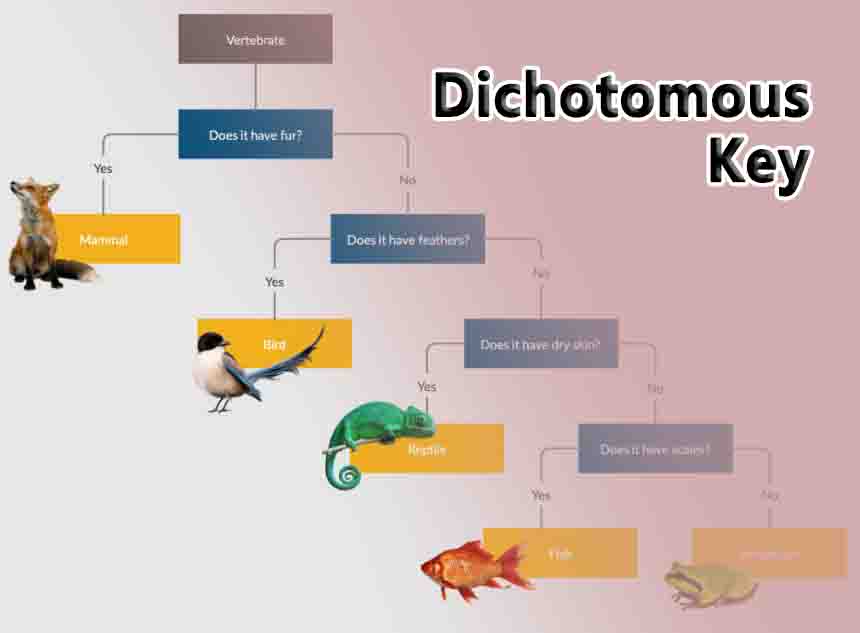Dichotomous Key Definition
A dichotomous key is a tool created by scientists to help scientists and laypeople identify objects and organisms.
Typically, a dichotomous key for identifying a particular type of object consists of a specific series of questions. When one question is answered, the key directs the user as to what question to ask next.
Dichotomous keys typically stress identifying species by their scientific name, as each individual species has a unique scientific name.
By contrast, common names for organisms – such as “white oak,” “chipmunk,” or “penguin” – often refer to many different species that look similar to each other.
So to determine with certainty which species you are looking at, the dichotomous key identifies species by their unique scientific name.
For example, in tree identification, a dichotomous key might ask whether the tree has leaves or needles. The key then directs the user down one list of questions if the tree has leaves, and a different question list if it has needles.
Dichotomous keys are very useful because they allow non-expert users to identify organisms by directing them to look at the known, important organisms. Many people might not know how to distinguish different species of pine trees based on the arrangement of needles on a branch, for example, but the key would be able to ask them that question and give them useful information based on the result.
The name comes from the Greek “di” for “two” and “tome” for “cutting instrument.”
As the name suggests, a dichotomous key arrives at the answer to species identification by presenting a series of questions with two possible answers. Each answer that is given cuts down the list of possible candidate species be eliminating, for example, all trees with leaves.
Dichotomous keys are very useful for identifying an organism as a member of a single, closely-related group of organisms. In many environments this is sufficient to fully identify the species. However, complications may arise if multiple closely-related species, which may have very similar characteristics, live in the same geographic area.
A related type of identification key, the polychotomous key, uses a similar question-and-answer branching format.
How to Use a Dichotomous Key
Dichotomous keys allow their users to reliably identify objects in the natural world.
Dichotomous keys are most often used for identifying plant and animal species based on their characteristics. However, they can also be used to identify minerals – and in theory, any type of object that can be identified by a known set of observable characteristics.
Types of Dichotomous Key
Though all dichotomous keys function in the same way, there are several different ways of presenting them to the user:
Nested Style
In a nested display of a dichotomous key, the next question in a series appears “nested” under the answer leading to that question.
This is often achieved by using indentations, with each question following the first one being further indented to distinguish it from the rest.
Linked Style
In a linked style of dichotomous key, questions are laid-out in list form.
Each answer directs the user which question to ask next, and the user must find the correct question in order to properly identify the organism.
Branching Tree
In a “branching” or “tree” layout of a dichotomous key, each of an organism’s characteristics are laid out in a style similar to a flow chart or tree of life.
Each question or characteristic begins a new “branch” of the tree, with each subsequent question being a sub-branch.
Identification is reached at the end of the tree’s “branches.”
Computer Program
With handheld computers becoming more common, identification keys are increasingly being converted into computer program form.
This method allows the user to answer questions one at a time, and have the correct follow-up question automatically presented.
Much like popular online quizzes, in this way the user can reach the correct species identification after answering a series of either-or questions.
Examples of Dichotomous Key
Publicly available examples of dichotomous keys can be found here:
- Trees of the Pacific Northwest
- Amoeba Sisters Dichotomous Key
- Mark Drollinger Bird Key
Related Biology Terms
- Scientific name – The unique name given to a species by scientists. A scientific name contains two parts – the genus name is capitalized and tells which other species this organism is related to, while the species name is specific only to this unique species.
- Species – A group of organisms with similar characteristics that can produce fertile offspring together.
- Taxonomy – The branch of science concerned with the classification of organisms.

